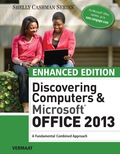
EBK ENHANCED DISCOVERING COMPUTERS & MI
1st Edition
ISBN: 8220100606922
Author: Vermaat
Publisher: YUZU
expand_more
expand_more
format_list_bulleted
Expert Solution & Answer
Chapter 8, Problem 24SG
Explanation of Solution
Cloud storage:
Cloud storage is a computing service, which is used to sustain, manage, backup the data remotely and made available to other users through a network connection and its fee amount is varying based on the requirements of users.
- That is, this service is used to store the data in cloud instead of storing in the local drives such as hard disk, SSD, and so on.
Advantages of cloud storage:
The advantages of cloud storage are given below:
- The cloud storage files are accessed from any system through internet access.
- It rapidly stores the huge amount of video files, audio files, and graphical files...
Expert Solution & Answer
Trending nowThis is a popular solution!

Students have asked these similar questions
I need to define and discuss the uses of one monitoring or troubleshooting tool in Windows Server 2019. thank you
I would likr toget help with the following concepts:
- Windows Server features
- Windows Server versus Windows 10 used as a client-server network
I need to define and discuss the uses of one monitoring or troubleshooting tool in Windows Server 2019. thank you
Chapter 8 Solutions
EBK ENHANCED DISCOVERING COMPUTERS & MI
Ch. 8 - Prob. 1SGCh. 8 - Prob. 2SGCh. 8 - Prob. 3SGCh. 8 - Prob. 4SGCh. 8 - Prob. 5SGCh. 8 - Prob. 6SGCh. 8 - Prob. 7SGCh. 8 - Prob. 8SGCh. 8 - Prob. 9SGCh. 8 - Prob. 10SG
Ch. 8 - Prob. 11SGCh. 8 - Prob. 12SGCh. 8 - Prob. 13SGCh. 8 - Prob. 14SGCh. 8 - Prob. 15SGCh. 8 - Prob. 16SGCh. 8 - Prob. 17SGCh. 8 - Prob. 18SGCh. 8 - Prob. 19SGCh. 8 - Prob. 20SGCh. 8 - Prob. 21SGCh. 8 - Prob. 22SGCh. 8 - Prob. 23SGCh. 8 - Prob. 24SGCh. 8 - Prob. 25SGCh. 8 - Prob. 26SGCh. 8 - Prob. 27SGCh. 8 - Prob. 28SGCh. 8 - Prob. 29SGCh. 8 - Prob. 30SGCh. 8 - Prob. 31SGCh. 8 - Prob. 32SGCh. 8 - Prob. 33SGCh. 8 - Prob. 34SGCh. 8 - Prob. 35SGCh. 8 - Prob. 36SGCh. 8 - Prob. 37SGCh. 8 - Prob. 38SGCh. 8 - Prob. 39SGCh. 8 - Prob. 40SGCh. 8 - Prob. 41SGCh. 8 - Prob. 42SGCh. 8 - Prob. 43SGCh. 8 - Prob. 44SGCh. 8 - Prob. 45SGCh. 8 - Prob. 46SGCh. 8 - Prob. 47SGCh. 8 - Prob. 1TFCh. 8 - Prob. 2TFCh. 8 - Prob. 3TFCh. 8 - Prob. 4TFCh. 8 - Prob. 5TFCh. 8 - Prob. 6TFCh. 8 - Prob. 7TFCh. 8 - Prob. 8TFCh. 8 - Prob. 9TFCh. 8 - Prob. 10TFCh. 8 - Prob. 11TFCh. 8 - Prob. 12TFCh. 8 - Prob. 1MCCh. 8 - Prob. 2MCCh. 8 - Prob. 3MCCh. 8 - Prob. 4MCCh. 8 - Prob. 5MCCh. 8 - Prob. 6MCCh. 8 - Prob. 7MCCh. 8 - Prob. 8MCCh. 8 - Prob. 1MCh. 8 - Prob. 2MCh. 8 - Prob. 3MCh. 8 - Prob. 4MCh. 8 - Prob. 5MCh. 8 - Prob. 6MCh. 8 - Prob. 7MCh. 8 - Prob. 8MCh. 8 - Prob. 9MCh. 8 - Prob. 10MCh. 8 - Prob. 2CTCh. 8 - Prob. 3CTCh. 8 - Prob. 4CTCh. 8 - Prob. 5CTCh. 8 - Prob. 6CTCh. 8 - Prob. 7CTCh. 8 - Prob. 8CTCh. 8 - Prob. 9CTCh. 8 - Prob. 10CTCh. 8 - Prob. 11CTCh. 8 - Prob. 12CTCh. 8 - Prob. 13CTCh. 8 - Prob. 14CTCh. 8 - Prob. 15CTCh. 8 - Prob. 16CTCh. 8 - Prob. 17CTCh. 8 - Prob. 18CTCh. 8 - Prob. 19CTCh. 8 - Prob. 20CTCh. 8 - Prob. 21CTCh. 8 - Prob. 22CTCh. 8 - Prob. 23CTCh. 8 - Prob. 24CTCh. 8 - Prob. 25CTCh. 8 - Prob. 26CTCh. 8 - Prob. 27CTCh. 8 - Prob. 1PSCh. 8 - Prob. 2PSCh. 8 - Prob. 3PSCh. 8 - Prob. 4PSCh. 8 - Prob. 5PSCh. 8 - Prob. 8PSCh. 8 - Prob. 9PSCh. 8 - Prob. 10PSCh. 8 - Prob. 11PSCh. 8 - Prob. 1.1ECh. 8 - Prob. 1.2ECh. 8 - Prob. 1.3ECh. 8 - Prob. 2.1ECh. 8 - Prob. 2.2ECh. 8 - Prob. 2.3ECh. 8 - Prob. 3.1ECh. 8 - Prob. 3.2ECh. 8 - Prob. 3.3ECh. 8 - Prob. 4.1ECh. 8 - Prob. 4.2ECh. 8 - Prob. 4.3ECh. 8 - Prob. 2IRCh. 8 - Prob. 3IR
Knowledge Booster
Similar questions
- Please solve and answer the questions correctly please. Thank you!!arrow_forwardConsidering the TM example of binary sum ( see attached)do the step-by-step of execution for the binary numbers 1101 and 11. Feel free to use the Formal Language Editor Tool to execute it; Write it down the current state of the tape (including the head position) and indicate the current state of the TM at each step.arrow_forwardI need help on inculding additonal code where I can can do the opposite code of MatLab, where the function of t that I enter becomes the result of F(t), in other words, turning the time-domain f(t) into the frequency-domain function F(s):arrow_forward
arrow_back_ios
SEE MORE QUESTIONS
arrow_forward_ios
Recommended textbooks for you
 Enhanced Discovering Computers 2017 (Shelly Cashm...Computer ScienceISBN:9781305657458Author:Misty E. Vermaat, Susan L. Sebok, Steven M. Freund, Mark Frydenberg, Jennifer T. CampbellPublisher:Cengage Learning
Enhanced Discovering Computers 2017 (Shelly Cashm...Computer ScienceISBN:9781305657458Author:Misty E. Vermaat, Susan L. Sebok, Steven M. Freund, Mark Frydenberg, Jennifer T. CampbellPublisher:Cengage Learning

Enhanced Discovering Computers 2017 (Shelly Cashm...
Computer Science
ISBN:9781305657458
Author:Misty E. Vermaat, Susan L. Sebok, Steven M. Freund, Mark Frydenberg, Jennifer T. Campbell
Publisher:Cengage Learning
